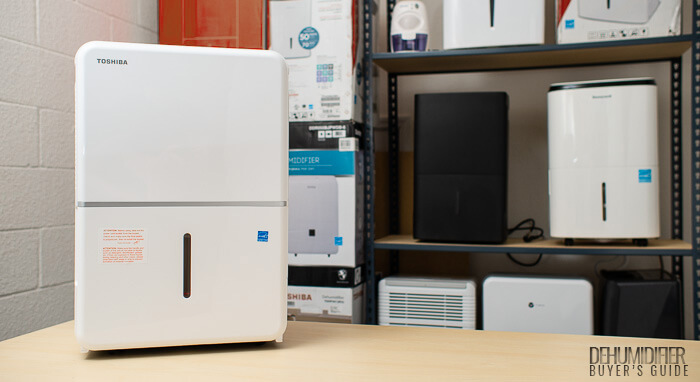
- Doesn’t require an adapter for gravity drainage
- Has an indicator light to alert you when defrost mode is activated
- Features excellent cord storage
- Poor performance in our moisture removal tests
- Below average energy efficiency and hygrometer accuracy
- A thoroughly average performer in most other categories
- Dehumidifier
- Instruction Manual
| Energy Efficiency | 3.0 |
| Noise Output | 3.5 |
| Moisture Removal | 2.5 |
| Hygrometer Accuracy | 3.0 |
| Durability | 3.5 |
| Adjustability | 3.5 |
| Versatility | 4.5 |
| Extra Features | 4.5 |
| Ease of Use | 3.5 |
| Portability | 4.0 |
| Warranty | 3.5 |
| Value | 3.5 |
| Editor's Score | 3.7 |
Quick Review Summary
The Toshiba TDDP5012ES2 is an average dehumidifier. It has most of the features and much of the functionality you might want in a dehumidifier, but it doesn’t do anything especially well.
This unit was also only an average to below average performer in our hands-on performance testing. Its performance in those tests as well as all of its features and functionality are covered in detail below.
Performance Test Results
Energy Efficiency
The Toshiba’s measured power draw was 578 watts. The 50 pint units we tested had a measured power draw in the 560 to 610 watt range with most units drawing approx. 570 watts. Thus, the Toshiba’s power draw was ever so slightly higher than average.
The real concern here is its performance in our moisture removal tests. The Toshiba took much longer than most other 50 pint units we tested to dehumidify our test space from 90% down to 40% relative humidity (more on this test in just a moment).
Energy efficiency is dependent on two factors – power draw and how long an appliance draws that power for – i.e. how long it takes an appliance to do a particular job.
The TDDP5012ES2 not only had a slightly higher than average power draw but it also took much longer to dehumidify in a real world environment in our testing. This gives this unit below average energy efficiency compared to all of the other 50 pint dehumidifiers we tested.
Noise Output
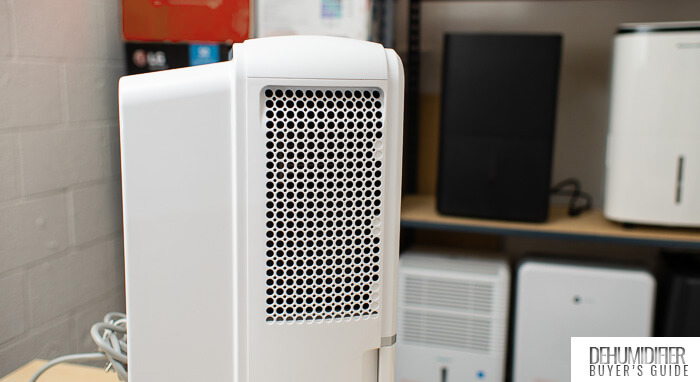
We placed a sound meter right above the control panel and 10 ft. away from the dehumidifier to measure its raw noise output.
The Toshiba is a side exhaust unit and so it had an advantage in our testing. Why? Because its side exhaust directed much of the noise away from the dehumidifier – and away from the sound meter. Top exhaust units emitted noise directly at the sound meter when it was placed above the unit’s control panel. 10 ft. away from the dehumidifier this advantage was less pronounced.
In any case, our testing showed side exhaust units to have a lower raw noise output than top exhaust units. The same applies to the Toshiba. Because it is a side exhaust unit it was tested to be “quieter” than most other 50 pint dehumidifiers we tested.
On high fan speed above the unit’s control panel it was measured 61.2 dB of noise output. 10 ft. away it was measured at 52.4 dB. The “quietest” 50 pint dehumidifier we tested, the hOmeLabs HME020031N, was measured at 59.3 dB and 50.3 dB in the same respective tests. Top exhaust units were measured at 70+ dB and approx. 54 dB in the same respective tests.
Note, however, that raw noise output is only part of the equation when it comes to evaluating dehumidifier noise output. Another important consideration is the quality of the noise.
Here, the Toshiba, like all the other side exhaust units we tested, didn’t do as well.
You may have wondered why we didn’t mention low fan speed numbers earlier. The reason is this: you’ll almost never want to run a dehumidifier on low fan speed.
Why? Because on low fan speed it won’t remove moisture as fast AND the white noise the fan produces won’t hide compressor noise nearly as well.
The Toshiba’s compressor makes quite a bit of noise (just like the compressor in most other 50 pint units we tested). And because its side exhaust sends all fan noise in a particular direction, it doesn’t mask compressor noise very well (unless you point the side exhaust directly at you of course).
Top exhaust units better distribute fan noise throughout a whole room (the noise is directed upwards omnidirectionally throughout the whole room). For this reason top exhaust units are “loud” but most of that loudness comes from fan noise. And it’s actually a good thing that you’re hearing more fan noise (due to the upward facing exhaust) with these units, because otherwise you’d be hearing more compressor noise, and that’s a much less pleasing noise to listen to.
Moisture Removal
We measured how long it took each 50 pint dehumidifier we tested to lower room humidity from 90% down to 40% and then from 80% down to 50% (an easier test).
We saw much more variance in the first test (90 to 40%) than the second test (80 to 50%) as it was by far the more difficult test. Most 50 pint dehumidifiers can handle 80% humidity just about equally well and can lower room humidity down to 50% relatively easily. The true test is the 90 to 40% test as 90% RH represents extreme moisture levels and 40% RH represents very dry air.
It took the Toshiba 12 minutes, 42 seconds to lower room humidity from 90% down to 40% in our 50 sq. ft. test space. For comparison, most other 50 pint units took only 10 to 11 minutes. The top rated Frigidaire took only 7 minutes, 56 seconds.
It took the TDDP5012ES2 6 minutes, 44 seconds to lower room humidity from 80% down to 50%. Most other 50 pint units had a time in the 5 and a half to 6 minute range. The top rated Frigidaire was again a bit of an outlier with a time of 5 minutes, 19 seconds.
These results speak for themselves. The Toshiba was an especially poor performer in both moisture removal tests.
Hygrometer Accuracy
The TDDP5012ES2 also doesn’t have a very accurate hygrometer. It often displayed readings up to 4% above the actual room humidity. Top rated units were accurate to within 2% of actual room humidity.
Included Features, Functionality, Build Quality, Warranties, and Value
Durability (Build Quality)
General Impressions
This unit features average build quality. It doesn’t feature any parts or materials that make us especially concerned about its long term durability, but it also doesn’t feature any parts or materials that make us especially confident about its long term durability.
Consumer Feedback
This unit is essentially brand new to market at the time of the writing of this editorial review. We usually survey consumer reviews written after a few years of ownership to see if there are any issues with the unit we may have missed during testing. We can’t do that as of yet with the Toshiba since it’s only been on the market for a few months.
Overall Category Score
The unit earns an average 3.5 for durability.
Adjustability
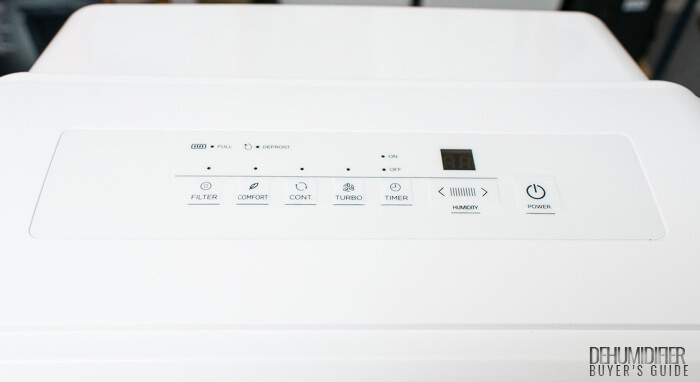
This unit features a timer that can be set in 1 hour increments up to 24 hours. Most other 50 pint units allow you to set the timer in half hour increments up to 12 hours, and then 1 hour increments from 13 to 24 hours.
The Toshiba features two fan speeds. Again, you’ll almost always want to use only one – high fan speed. There are models on the market with three fan speeds.
This unit does feature a continuous mode. On this setting the unit will run continuously until you manually shut it off. Most other 50 pint units we tested also come equipped with this mode.
The TDDP5012ES2 does come with an auto mode called “comfort” mode. We’ll say more about this in the next section on versatility.
Overall Category Score
The unit again scores an average 3.5/5 in the category.
Versatility
Set Humidity Range
The Toshiba allows you to set a desired humidity level between 35% and 85% humidity. You can adjust the setting in 5% increments.
On this “manual” mode the unit will cycle off automatically when the built-in hygrometer reads that room humidity matches the set humidity.
The unit’s “comfort” mode sets a desired humidity level automatically. And then the unit works much the same as it does on “manual” mode. Note that you’ll probably never want to use “comfort” mode as you’ll be able to establish the exact humidity level that’s comfortable for you by simply adjusting the desired humidity level on “manual” mode over the course of a few days. For example, you might set the unit to 55% RH on the first day, find that it’s not dry enough, then set it to 50% RH the next day, and from that day forward just leave it on 50% RH for many months as 50% RH may be comfortable for you. In contrast, “comfort” mode might set the unit to 55% RH, you may not be comfortable at this RH, and then you’ll set a lower desired RH manually anyway.
Operating Temperature Range
The Toshiba’s minimum operating temperature is 41° F. The user manual doesn’t state a maximum but we think it’s safe to assume it’s in the 89° to 90° F much like every other compressor based dehumidifier on the market.
Gravity Drainage
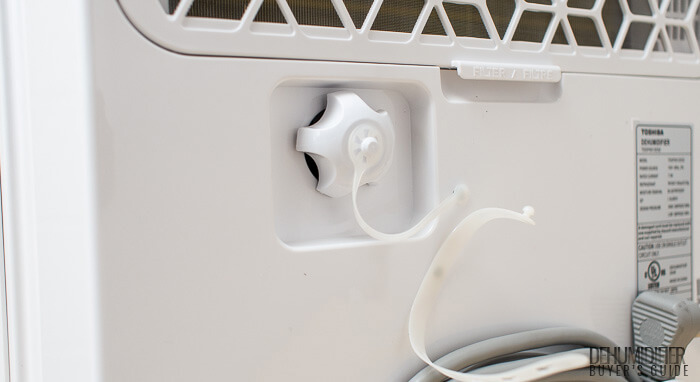
The unit has a drain outlet that doesn’t require an adapter for use. Certain models, like the LG UD501KOG5 and Keystone KSTAD504D, require that you install an adapter before connecting a garden hose to the outlet.
Built-in Pump
The TDDP5012ES2 doesn’t feature a built-in pump. You can, however, still pump collected moisture by draining through the gravity drain outlet into a condensate pump (purchased separately).
Overall Category Score
The Toshiba earns a 4.5/5 in the category.
Extra Features
Temperature Reading
This unit does not display current room temperature.
Defrost
This unit features a defrost mode with an accompanying defrost indicator light (on the main control panel). Defrost mode is activated if frost builds up on the unit’s evaporator coils (the evaporator is found behind the unit’s back grille – see the photo below). On defrost mode the compressor shuts off and the fan continues to run to melt the frost. The defrost indicator light alerts you when defrost mode is activated.
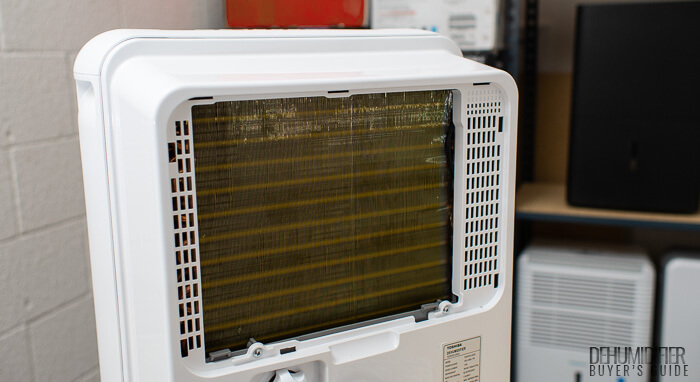
Check Filter
This unit does feature a check filter light on its control panel.
Overall Category Score
The Toshiba earns a 4.5/5 in the category.
Ease of Use
LED Display Clarity
The display is low quality but easy enough to read.
Setup Difficulty
The unit is easy to setup and use.
Filter Removal Difficulty
The unit’s filter is easy to access and remove. It pulls out of the top of the back of the dehumidifier.
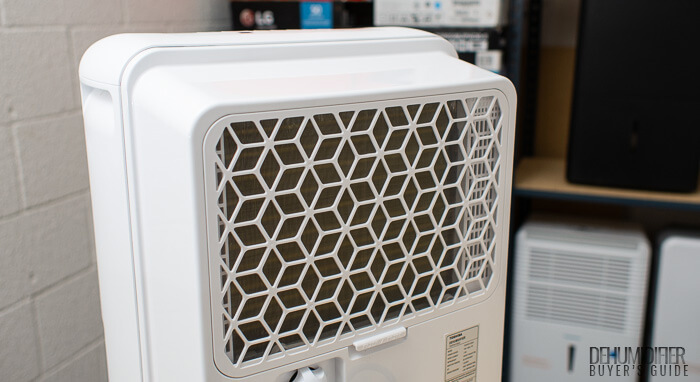
Manual Clarity
The TDDP5012ES2 manual is easy to follow and understand.
Water Tank Size
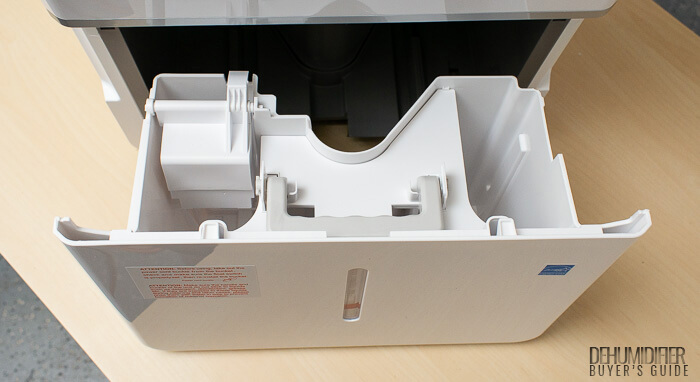
The unit’s water tank has a capacity of 14 pints – right around the average for the 50 pints/day size class. Some high capacity units have a smaller tank (e.g. the Keystone KSTAD504D has a 12 pint tank) while others have a much larger tank (e.g. the Frigidaire FFAD5033W1 has a 16.9 pint tank). The larger the tank, the more infrequently you have to empty and replace it (unless you’re using gravity drainage, of course).
Overall Category Score
The Toshiba earns average marks in the category – a 3.5/5.
Portability
The TDDP5012ES2 weighs just under 44 lb. The average for the 50 pint size class is around 43 lb.
The unit features side pocket handles and a plastic “buckle” on the back around which you can wrap the unit’s power cord.
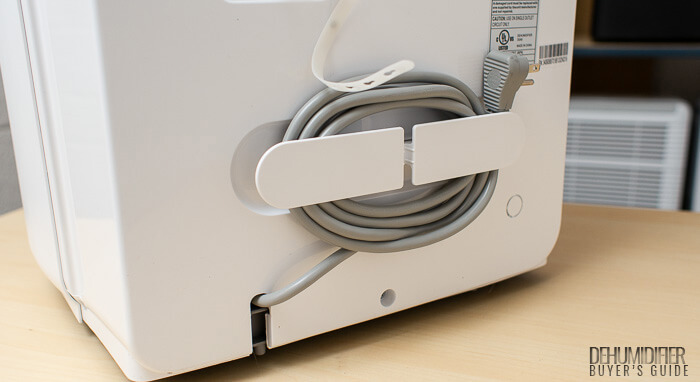
Overall Category Score
The Toshiba earns a slightly above average 4/5 for portability has it has just about an average weight for a 50 pint dehumidifier and it features excellent cord storage.
Warranty (Manufacturer’s)
The TDDP5012ES2 comes with an industry standard 1 year warranty.
Only a handful of 50 pint dehumidifiers come with a longer warranty. The top rated Frigidaire FFAD5033W1 isn’t one of them. Like the Toshiba it only comes with a 1 year warranty.
The hOmeLabs HME020031N does come with a longer warranty – 2 years plus an additional 6 months if you register your purchase with the manufacturer.
Value
The Toshiba TDDP5012ES2 tends to be priced towards the lower end of the range for 50 pint units. But it’s a very average, if not below average dehumidifier overall. And since value is just as much about what you get as it is about what you pay, this unit earns only an average 3.5/5 for value.
Have a question or comment? Let us know below.
DO NOT BUY THIS UNIT! Same issue with coils freezing and auto defrost not working 15 months after purchase, less 6 months of not using it over the winter. NEVER BUYING TOSHIBA PRODUCTS AGAIN!
When it works, it works good. Started frosting up about 1 month after 1 year warranty expired. Cleaned coils as suggested. Did not help. Could not find diy repair parts. Instead bought programmable outlet timer at Walmart that turns on every hour for 45 minutes and off for 15 minutes which is long enough to melt frost buildup. Will see if that works going forward.
Do you have to remove bucket in order for the gravity drain to operate ?
Its taking forever to lower humidity we had it 3 yrs is it time to get a new one?
Purchased the 50pt from H.D. 2021 and now does not work, called and was told to take the unit into a bath room and turn on the hot water until a lot of steam and put unit in and turn on as see if it works, WHAT. Second one purchased from H.D. want buy another one. 1 yr warranty should tell you something about the quality of product. Used this one approx 11 months over the past 2 yrs, do not run in winter as the furnance runs keeping mosture out of basement. $249.00 cost, worthless.
my dehumidfifier is not working ..not removing water from the room
We only use our Toshiba in the basement and only in the summer.
It’s lasted almost 2 summers.
Ice keeps building up on the back of the unit, no matter how many times it melts.
Junk product. Do not buy.
How often do I have to set timer? I set it and then look at it and both lites are off . What’s up.
I don’t buy this product anymore after a year and a half it’s not working
Stop dehumidifie after 14 months use. Please avoid this product. No reliability and no dependability (with one year warranty).
I have 2 dehumidifier from this company. Never buy again. Both compressors stop working after 1 year and month of use. A rip off company. Don’t buy. Worked fine until the compressors quit working sad. I had a sears for over 22 years until it quit.
the automatic drain has stopped working and the water goes to the tank. Can the water be directed to the automatic drain?
Hi. Great review. I was searching the web for watts used, and Toshiba couldn’t help, but you could. I think 12 minutes isn’t that much worse than 11 minutes, and you are being harsh on this unit. Also, I have the 22 pint unit. If you are comparing a 22 pint unit against a 50 pint unit, of course it will be slower. I hope you are apples to apples here. Anyways, great review. Tx
this is the second dehumidifier that failed just as the one year warrenty expired. no more toshibas mine still looks like it came out of the box. kept it clean and it still iced up, do not recommend purchase of any toshiba or GE dehumidifiers
how many square feet is a Toshiba TDDP5013ES2C recommended for?
Just purchased/set up TDDP5013ES2. Does the fan run continuously?
Also when I pull the bucket out it shows P2 on the screen. What does that indicate?
When all else fails, read the instructions. Page 8 of the manual.
I can’t adjust the humidity sensor level up or down my dehumidifier it sits at 71.
It displays the room humidity as a default. When you touch the keypad, it displays the humidity it is set to work to, while you adjust it. After a few seconds of not touching it, it switches back to what the room is. Probably your 71 is the room.
How do I send in my warranty? Keeps coming back wrong address and it is your form.
Where do I send my warranty card?